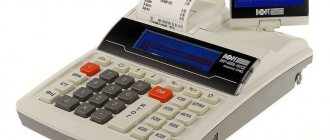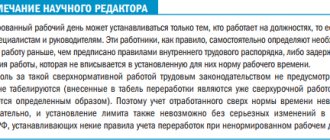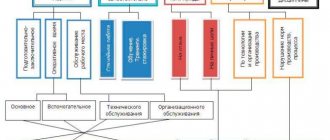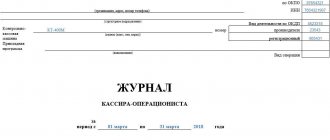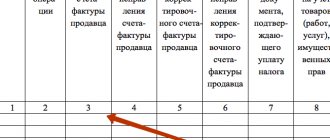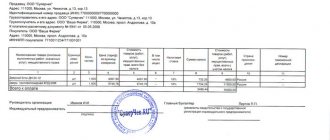- August 31, 2019
- Accounting
- Marina Lobacheva
Companies use a cash book to keep track of cash. It is used by both companies and private entrepreneurs. With its help, the procedure for preparing various financial statements is greatly simplified. Filling out the cash book is carried out by an appointed responsible specialist, who is vested with the appropriate powers based on the order of the head of the company. Usually it is represented by an accounting employee, but some individual entrepreneurs carry out this process independently.
Why is a cash book needed?
Based on the information contained in this document, the financial condition of any company is monitored. It can even be used by tax authorities auditing a company. Additionally, the book is useful for the head of any company, since with its help you can easily understand how much money the company receives, as well as how much money is spent on certain purposes.
The cash book is mandatory documentation, and it is presented in each company in a single copy. According to the law, it is not allowed to maintain several books containing different data at once.
When the cashier-operator’s journal is submitted to the Federal Tax Service
- It is necessary to redo the registration of the cash register card.
- The journal is finished and a new book needs to be started.
- In the case of an audit that is organized and initiated by the tax office itself (read separately about the types of audits in the article on our website).
However, the law does not prohibit the installation of any number of cash registers by a company. However, all of them must be installed correctly and must be registered.
It is important to understand the difference between a company's cash register and a cash register cash register.
Thus, cash received using cash register equipment:
- Must be accounted for on the same day they are received.
- Can be returned to the buyer only on the same day they were received from him. (There are regulations for implementing the procedure for returning goods, and they will be considered separately).
- These funds are not available at the beginning of the shift and after closing.
- The funds are handed over for collection during the same day, or at the end of the cash day - to the company's cash desk. In this case, a cash receipt order is issued at the end of the shift and the transfer of money.
- The cash cabinet/box/safe may only contain funds for change. In this case, funds are issued at the beginning of the cash register shift from the company's cash desk. Again, an order (expenditure) is issued.
Important! Closing the cash register the next day will be considered a gross violation. If detected, the cashier will be fined in the amount of up to 4 thousand rubles for one mistake. And the company will pay in the amount of about 50 thousand rubles.
Who is in charge?
Filling out the cash book can be done by hand or using a computer. This process is carried out by a cashier or accountant who is appointed responsible for maintaining the book using a special order. He is represented by the financially responsible person. His responsibilities include the following:
- competent filling of the cash book;
- issuance and acceptance of money or other material assets and securities;
- acceptance and issuance of various accountable documentation;
- filling out income or expense cash orders that are required when issuing salaries or bonuses;
- control over various cash transactions.
The activities of the cashier are controlled by the chief accountant of the enterprise. If a businessman is an individual entrepreneur, then he independently fills out this document.
_______________________
*Regulations on the procedure for using cash register equipment, payment terminals, automatic electronic devices, vending machines and accepting cash, bank payment cards when selling goods, performing work, providing services, carrying out activities in the field of gambling, lottery activities, conducting electronic interactive games , approved by Resolution of the Council of Ministers and the National Bank of the Republic of Belarus dated July 6, 2011 No. 924/16 (hereinafter referred to as Regulation No. 924/16).
The book can be maintained in 2 ways - manually or using software and hardware
The cashier's book is maintained for each piece of cash register equipment.
This rule does not apply to cash register equipment:
– used in their activities by banks, individual entrepreneurs - payers of the single tax from individual entrepreneurs and other individuals;
– built into automatic electronic devices, vending machines, and special computer systems;
– with an established means of control by tax authorities.
The form of the cashier's book is given in Appendix 2 to Regulation No. 924/16.
Organizations accepting cash must ensure that the book is available at the location where cash register equipment is installed |*|.
* Letter of the Ministry of Transport of the Republic of Belarus dated August 12, 2014 No. 01-27/6472 “On accepting cash” is available to all readers of GB.BY
This rule does not apply to cash register equipment used:
– on buses of suburban, intercity, international routes on a regular basis;
– buses with a maximum weight of no more than 5,000 kg on express city routes;
– taxi cars;
– when trading according to samples with delivery of goods to your home or other specified place.
The cashier's book is maintained daily in chronological order based on the readings of cash register equipment and supporting documents.
That is, when filling out the book, what matters is the readings of cash register equipment and documents, and not the presence or absence of sales during the day.
The cashier's book should be filled out without marks with a fountain pen or ballpoint pen.
As follows from the explanations of the specialists of the Ministry of Taxes and Taxes, cashiers, in addition to the specified types of pens, have the right to use other types of pens. The reference in paragraph 14 of Regulation No. 924/16 to a fountain pen or ballpoint pen was merely intended to prevent situations that would result in questions and (or) doubts about the original recording (for example, when the ink evaporates over time, fades, and it is impossible to make out the recording possible or use a pen with ink that can be easily removed) |*|.
* The procedure for filling out the cashier's book with a gel pen is available to all GB.BY readers
Maintaining books manually. In this case, the organization must, before using the book, lace it up, number it and seal it with the signatures of the head of the organization and the person in charge of accounting, as well as with the seal of the organization.
Maintaining a book using software and hardware. This method of maintaining a book is permitted provided that all details provided in the form of the cashier’s book are filled out.
In this case, the sheets of the cashier’s book are formed in the form of the output form “Loose sheet of the cashier’s book”. In the last output form “Loose sheet of the cashier's book” for each month the total number of sheets of the cashier's book for each month must be printed, and in the last such form for the calendar year - the total number of sheets of the cashier's book for the year. The sheets of the cashier's book in the output forms are numbered in ascending order from the beginning of the year.
The output forms “Loose sheet of the cashier's book” are bound in chronological order throughout the year.
At the end of the calendar year (or as necessary), the total number of sheets for the year is certified by the signatures of the head of the legal entity and the person in charge of accounting, as well as the seal of the legal entity.
Important! The output form “Cashier’s Book Load Sheet” must be printed daily on paper and signed by the cashier.
The procedure for filling out the cashier's book at the beginning of the working day (shift)
A cashier working on cash register equipment must begin his working day (shift) by filling out the gr. 1–4 cashier's books (see Table 1).
Please note that the procedure for issuing cash to the cashier before the start of the working day is determined by the Instruction on the procedure for conducting cash transactions and the procedure for cash settlements in Belarusian rubles on the territory of the Republic of Belarus, approved by Resolution of the Board of the National Bank of the Republic of Belarus dated March 29, 2011 No. 107 (hereinafter referred to as Instruction No. 107).
Thus, to ensure the uninterrupted work of cashiers and authorized persons for issuing change when selling goods (performing work, providing services), taking into account the need for safety and the specifics of the work, the organization independently determines in writing the amount of need for change cash for each cashier’s workplace, authorized person ; time of handing over cash by cashiers to the chief (senior) cashier, etc.
The established amount of need for change cash is communicated to each cashier and authorized person in writing (clause 14 of Instruction No. 107).
The amount of cash required for expense transactions before the start of the working day is given by the chief (senior) cashier to other cashiers in advance against a signature in the book of accounting for cash accepted and issued by the cashier (hereinafter referred to as the book of accounting). The form of this book is contained in Appendix 4 to Instruction No. 107.
It must be numbered, laced and sealed with the seal of a legal entity or division. The number of sheets in the accounting book of cash accepted and issued by the cashier is certified by the signatures of the head and chief accountant of the legal entity or division.
The book is used to account for:
– cash issued by the chief (senior) cashier from the cash desk of a legal entity or division to other cashiers;
– return of cash and cash documents on transactions performed to the chief (senior) cashier. The book of cash accepted and issued by the cashier is kept by the chief (senior) cashier.
At the end of the working day, cashiers report to the chief (senior) cashier about the advance received and cash accepted for transactions performed against a receipt in the accounting book (clause 60 of Instruction No. 107).
The procedure for filling out the cashier's book at the end of the working day (shift)
At the end of the working day (shift), the cashier must:
1) display on cash register equipment in accordance with the operational documentation:
– control tape – for cash register equipment with an electronic journal, when the control tape is formed in a single operating cycle with the receipt tape when registering a cash transaction, but is processed separately.
The requirement to create a control tape does not apply to cash register equipment with an installed means of control by tax authorities;
– daily (shift) report (Z-report) (clause 18 of Regulation No. 924/16);
2) fill out on the basis of the received Z-report and supporting documents, regardless of the presence or absence of sales during the day. 5–14 of the cashier's book (clause 14 of Regulation No. 924/16) (see Table 2).
Error correction procedure
If a mistake is made when filling out the cashier's book, it can be corrected. To do this, you just need to cross out the erroneous entry and write the correct one above.
Moreover, each correction must be certified by the signatures of a person authorized to do so by the legal entity. If by order of the organization a cashier working on cash register equipment is authorized to perform these actions, then corrections are made to the cashier’s book by this cashier |*|.
* The procedure for correcting an error made by a trade organization in the cashier’s book is available to subscribers of the electronic “GB”
Practice filling out the cashier's book
Situation 1. Filling out the cashier's book in the absence of revenue in public catering
The organization has a small cafe, which does not generate revenue every day.
Is it necessary to fill out a cashier's book if there is no income?
It is necessary if the organization does not carry out seasonal trade.
Cash register equipment must be turned on and the cashier's book must be filled out at the beginning of the working day (shift) in accordance with the cafe's operating hours.
If the activities in the provision of catering services are irregular (seasonal), this fact is reflected in the operating hours of the cafe.
On days when, according to the operating hours, the business entity’s activities are not carried out and, accordingly, services are not provided, cash register equipment is not used, and the cashier’s book is not filled out.
From the editor:
The operating mode of public catering facilities must correspond to the operating mode specified in the document establishing the operating mode. Its form is contained in Appendix 22 to Resolution of the Ministry of Trade of the Republic of Belarus dated December 24, 2014 No. 41.
The seller is obliged to bring to the attention of visitors on a sign and (or) information plate located on all entrance doors or the facade of the structure (building, structure), temporary structure in which the public catering facility is located, in another place accessible to the visitor:
– name, type and class of the public catering facility;
– operating hours (clauses 4, , 12 of the Rules for the sale of certain types of goods and catering, approved by Resolution of the Council of Ministers of the Republic of Belarus dated July 22, 2014 No. 703).
Situation 2. Filling out a cashier's book on cash register equipment, which, if there are no sales during the day (shift), does not generate a Z-report
The organization uses a cash register equipment model in which it is impossible to generate a daily report (Z-report) without sales for the current day.
What, in this case, is the basis for making an entry in the cashier’s book at the end of the working day in the absence of revenue for the working day?
Z-report after certain operations involving cash register equipment.
The cashier is obliged at the end of the working day (shift) to fill out the cashier’s book based on the readings of cash register equipment and supporting documents, regardless of the presence or absence of sales during the day (clause 14 of Regulation No. 924/16).
In this regard, at the end of the working day (shift), he must issue a daily (shift) report (Z-report) in accordance with the operational documentation for cash register equipment (clause 18 of Regulation No. 924/16).
Certain models of cash registers included in the State Register of models (modifications) of cash registers and special computer systems used in the territory of the Republic of Belarus, in the absence of sales during the day (shift), do not generate a shift closing report (Z-report). In such cases, organizations need to use the recommendations of the manufacturers of these cash registers.
It follows from them that in order to ensure the possibility of generating a daily (shift) report (Z-report), it is necessary to carry out an official deposit of money (administrative cash transaction for registering the deposit of cash into a cash drawer) and an official withdrawal of money (administrative cash operation for registering the withdrawal of cash from cash drawer). After these steps, it is possible to perform an operation to generate a daily (shift) report (Z-report).
Taking into account the above, the cashier of the organization must, at the end of the working day (shift), fill out the relevant details provided for in the form of the cashier’s book, incl. number of the daily (shift) report (Z-report). If there are no sales during the working day, dashes are entered in the corresponding columns of the cashier’s book (7–9).
Situation 3. Registration of a cashier’s book when selling gift certificates
Retail trade networks and public service providers (hairdressers, beauty salons, entertainment centers) offer consumers gift certificates that differ in denomination, validity period, freedom of transfer, etc.
What is the procedure for registering a cashier's book when selling gift certificates?
The cashier is obliged to carry out the amounts of accepted cash and (or) funds when making non-cash payments using bank payment cards (including when making advance payments, prepayments, deposits and funds accepted as collateral) through cash register equipment |*|.
* The procedure for using cash register equipment when accepting cash is available for subscribers of the electronic “GB”
To confirm the acceptance of the specified amounts, he is obliged to:
– issue to the buyer (consumer) a payment document confirming payment for goods, performance of work, provision of services;
– place the cash received from the buyer in the cash box of cash register equipment (if available) or another place for a similar purpose (clause 17 of Regulation No. 924/16) |**|.
** Cash acceptance at type 1 duty-free shops is available for e-GB subscribers
Thus, transactions for the sale of gift certificates must be carried out through cash register equipment and accordingly reflected in the cashier's book.
The cashier's book must reflect the amount of revenue that was processed through cash register equipment on that working day (shift), incl. and from the sale of gift certificates. The basis is the data of the daily (shift) report (Z-report) displayed at the end of the working day (shift) on the cash register equipment.
Let us remind you that information about accepted cash is indicated in gr. 8 cashier's books, about non-cash transactions - in gr. 9.
Situation 4. Registration of a cashier's book in case of breakdown of cash register equipment
A trading organization plans to open a store in which 23 cash registers will be installed.
What should be indicated in the cashier's book if the machine breaks down during operation?
If a malfunction of cash register equipment or damage to the control device installed on it is detected, the cashier is obliged to:
1) stop accepting cash and (or) bank payment cards using it;
2) take a daily (shift) report (Z-report) and, based on its information, complete the completion of work in the manner indicated above.
If it is impossible to make a daily (shift) report (Z-report), a record should be made in the cashier's book about the malfunction of the cash register equipment and the amount of money received using this cash register equipment for a given working day (shift) before its malfunction is detected.
Shelf life of a completed cashier's book
The completed cashier's book must be stored for 1 year after the tax authorities have checked compliance with tax legislation and subject to the completion of the audit conducted within the framework of departmental control (if any) (clause 179 of the list of standard documents of the National Archival Fund of the Republic of Belarus generated in the course of the activities of state bodies , other organizations and individual entrepreneurs, indicating storage periods, approved by Resolution of the Ministry of Justice of the Republic of Belarus dated May 24, 2012 No. 140).
After the specified period, the cashier's book can be destroyed. When destroying, you should draw up an act on the allocation for destruction of documents and files that are not subject to storage.
For reference: the form of the act on the allocation for destruction of documents and files that are not subject to storage is contained in Appendix 17 to the Instructions for record keeping in government bodies and other organizations, approved by Resolution of the Ministry of Justice of the Republic of Belarus dated January 19, 2009 No. 4.
Filling rules
Each person appointed as the person responsible for filling out this documentation must understand how to properly maintain a cash book. To do this, the following rules and requirements are taken into account:
- data is entered into the documentation on the basis of special instructions issued by the Central Bank;
- It is allowed to maintain a document in paper or electronic form;
- Only forms that have a strictly established form are used for these purposes;
- It is not allowed to use your own form developed by employees of a separate company, since the law requires a single format to be used;
- a new book begins every year, so at the end of the year it can be used to determine how much money was earned and spent by the company;
- it is important to correctly number each sheet of the book, so skipping pages is a gross violation;
- all pages must be stitched together, and at the end the number of available sheets is written down;
- the document bears the signature of the director of the enterprise, as well as the seal of the company;
- If the book is kept in printed form, then two identical copies are made at once.
When maintaining documentation, the responsible person must strive to ensure that there are no blots, errors or corrections.
How to fill out a cash book: sample filling on paper
You can draw up a cash book either on paper or electronically. Each of these options has its own filling characteristics.
The paper form KO-4 is a journal printed in a printing house, filled out manually, or filled out on a computer and then printed, sheets of the cash book.
If the book will be filled out by hand, before starting work, you need to number and stitch all the sheets. On the back of the cover, a sheet of paper indicating the number of numbered sheets is glued to the lacing, and the seal and signatures of the manager and chief accountant are affixed. The title page indicates the name of the company and the period of use of the book.
The cash book sheet consists of two parts: the cash book loose leaf and the cashier's report, which are numbered with the same numbers. To fill out the sheet manually, carbon paper is required. The sheet is folded in half along the cut line, a carbon copy is placed in the middle, and the cashier fills in the non-tearable part (the first copy) with a ballpoint pen, and the tear-off part (the second copy) is copied.
Features for e-readers
Filling out the cash book manually is becoming less and less common, as many companies prefer to switch to electronic document management. Therefore, this document is filled out electronically. To complete this process correctly, the following rules are taken into account:
- as soon as the document is completely filled out, it must be printed;
- printed documentation is stapled and signed by the director of the company;
- if the responsible person in the company is responsible for maintaining the cash register in electronic form, then it is allowed to register the book quarterly;
- entries must be made daily by a designated person;
- The balance of money in the account must be indicated at the beginning of the day, and at the end of the day the total is summed up based on the transactions performed for one day of work;
- any transactions carried out during the day must be indicated in the book.
The advantages of using the electronic version include the fact that if the cashier makes any mistake for various reasons, it can be easily and quickly corrected.
Application of the cashier's journal
This register is created for each cash register.
It is opened at the time of registration of this equipment with the Federal Tax Service. Therefore, the cashier operator’s journal must be noted in the tax office. For this purpose, a register purchased from a printing house is used. The State Statistics Service provides a specialized form KM-4 for it. It is numbered, stitched and certified with the director’s visa and the company’s seal. After that, together with the documentation for the cash register, this book is sent to the tax office, which, next to the seal of the organization, puts its seal and the signature of the corresponding official.
The journal is filled out manually based on the cashier's report document. It reflects the receipt of income in the form of cash per day or shift. It registers a z-report, which summarizes the overall results for a certain period. At the enterprise, this responsibility is assigned to cashiers or their substitutes. If several reports were taken for the current day, each should be entered in the appropriate log fields.
Entries in the book are made constantly while the cash register is running. As soon as the last line is filled in, it must be sent along with the new one to the tax authority to register its change, which is reflected in the previously created cash register card for this organization.
Currently, it is necessary to use cash register with ECLZ, which is designed for one year. If you miss this deadline, the device is blocked and does not allow anything to be punched through it. When replacing it, the journal does not close, and the central service station employees make appropriate notes in it. Also, these specialists, in accordance with the concluded agreements, during the monthly maintenance of the cash register, can make notes on the work performed in the fields of the register.
Instructions for filling
If the cashier is not well versed in this work, then he should study an example of filling out a cash book. In fact, the procedure is considered quick and simple. To do this, you just need to follow the correct instructions:
- The book begins with a title page, which contains general information about the entrepreneur or company;
- indicate the personal data of the individual entrepreneur, provided by his full name, date of birth and passport details;
- if a document is filled out in a company, then its name, legal address and other significant details are provided;
- the title page indicates the period for which the documentation is kept;
- Next, the usual sheets of the book are filled in, intended for entering information about all operations carried out during the working day;
- each leaf has two parts that can be easily torn off;
- At the top is the date the information was entered, as well as the sheet number;
- Next is a table with 5 columns;
- the table indicates the document number, the entity from which the money was received or to whom the funds were issued, the account number, as well as the amount of income and expenses;
- at the end the balance at the beginning and end of the day is given;
- if after filling out the table there are empty lines left, then they should be crossed out using a capital letter Z, so that in the future it is impossible to enter any false information into the cash book;
- at the end of the sheet the signature of the cashier responsible for maintaining documentation is placed.
A sample of filling out the cash book can be found below.
Document structure
For the cashier-operator book, the sample filling is regulated by the requirements of Federal Law No. 54-FZ of May 22, 2003. It must be stitched, the sheets must be numbered, and at the end it must be sealed. It doesn’t matter whether the entire magazine is completely stitched or just the sheets; at the end, the thread with which the document was sewn must be sealed with a control sheet, the signature of the manager with a transcript, the number of sheets sewn and the stamp of the organization’s seal must be affixed.
How to fill out the cashier-operator book? A sample of the first page, also known as the title page, is filled out at the tax office upon receipt of the magazine. The details of the organization and the cash register equipment used are indicated here. Information about the cash register is filled in based on the manufacturer's passport. The start and end dates of journaling and the responsible person who is responsible for this are also indicated here.
Rules for correcting information
Often, in the process of maintaining documentation, responsible persons make some mistakes. Filling out a cash book is considered a simple process, but there is always a chance that incorrect information will be entered. Various clerical errors or typos, as well as corrections, are not welcome in official documentation.
Any correction may be considered a violation by the company, and therefore the person responsible may be subject to disciplinary action. Only minor errors are allowed that are not related to the indicated amounts and do not affect the summary. How to fix errors? For this, the following rules are taken into account:
- incorrect data is simply crossed out;
- The correct information is written at the top;
- a correctly corrected error is certified by the signature of the responsible cashier and accountant who checks the documentation;
- if errors are identified related to the size of the balance, then the sheet in the book is completely crossed out, after which a mark is made to cancel it;
- After crossing out one sheet, the second sheet is filled in.
It is the cashier who is responsible for filling out the document correctly, so if they make serious mistakes, it is important to draw up a special memo addressed to the company’s chief accountant. This note is reviewed by a specially created commission, after which the necessary changes are made. The accountant generates a certificate of the adjustments made. Only after this the page is canceled.
Stitching rules
The cashier appointed as the person responsible for maintaining documentation must understand not only the rules for filling out the cash book, but also the specifics of stitching it together. All sheets must be numbered and stitched. For this, high-quality special threads are used. After tying them, they should be on the back of the document.
A small piece of paper containing information about the number of sheets is glued to the unit. The information is certified by the company seal, after which the sheet is signed by the director.
Features of management
Individual entrepreneurs may not be responsible for maintaining a cash book, but they must keep records of their expenses and income. Therefore, it is most important to use this document for this purpose. If a businessman uses a cash book, then he must follow the rules for its design. There is no requirement to indicate the cash balance limit, and entrepreneurs do not draw up cash orders.
Companies are required to follow all requirements for this documentation. If there are errors or violations, this may become the basis for a more thorough inspection by Federal Tax Service employees.
An example of filling out a cash book manually can be studied below.
Is it possible not to print an electronic document?
Companies have the right to maintain a cash book electronically without printing it. In this case, the enterprise completely switches to electronic document management. The basis for filling out the cash book is any financial transaction performed in the company.
The ability to maintain documentation exclusively in electronic form appears only after the company purchases certain technical equipment. They are the ones who ensure data protection from fraudsters and hackers. By using them, it is ensured that the person in charge cannot in any way make a mistake. Additionally, documentation is protected from loss of information.
All electronic samples of the book must be signed using an electronic signature, which must meet the conditions of Federal Law No. 63. The electronic version is slightly different from the paper document in appearance, but it contains the same rows and columns.
If an entrepreneur decides to switch completely to the electronic version of the book, then he must prepare for serious expenses associated with the purchase of expensive equipment. The selected cashier must be able to operate this equipment.
Cashier-operator's book: sample filling when returning
In the activities of any company, returns of sold goods occur. The legislation provides for a number of cases in which the seller does not have the right to refuse to return the product to the consumer if it does not meet any specifications or has a manufacturing defect. Return transactions are reflected in the form of a total amount in the book of the cashier-operator. The return form is no different from other expense transactions. The only difference is that in most cases, the buyer, before receiving his money back, must write a statement addressed to the head of the organization. The application must be accompanied by a receipt of purchase.

